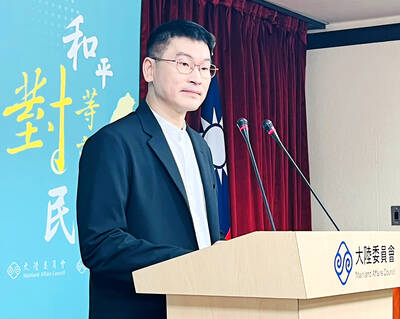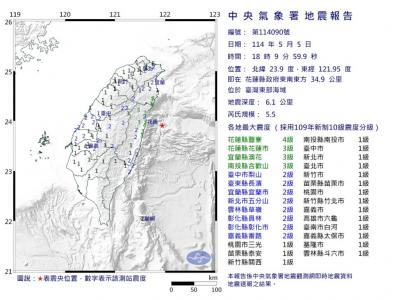Poor communication and surveillance capabilities have awakened interest in the military in blimps equipped with powerful sensors to conduct surveillance over disputed territory, possibly including the Diaoyutai Islands (釣魚台) and Itu Aba Island (Taiping Island, 太平島), reports are saying.
According to a recent report in Defense News, interest in acquiring such devices — known as aerostats — to increase the nation’s intelligence, surveillance and reconnaissance (ISR) capabilities increased in the wake of a Sept. 25 incident near the Diaoyutais, during which Japanese Coast Guard vessels engaged in primarily symbolic water cannon exchanges with the Coast Guard Administration (CGA) and about 40 Taiwanese fishing vessels.
Citing an unnamed military officer, the report said that the CGA and the navy had struggled to monitor developments during the clashes due largely to limited surveillance capabilities.
The military source said aerostats would be extremely useful if deployed at Pengjia Islet (彭佳嶼), located about 55km north of Keelung and 141km east of the Japan-controlled Diaoyutais, as well as on Itu Aba — the largest island in the Spratlys (Nansha Islands, 南沙群島) — which is controlled by Taiwan.
However, the source said such deployments would not necessarily constitute further militarization of the islets, because the blimps can also be used for disaster relief, surveillance of civilian maritime vessels, communication and search-and-rescue operations.
Taiwan’s current ISR capabilities in remote areas currently depend on E-2T/K “Hawkeye” early-warning aircraft. Twelve refurbished P-3C “Orion” maritime surveillance aircraft, which Taiwan has purchased from the US, are to augment those capabilities once they enter service starting next year. Taiwan is also developing a number of unmanned aerial vehicles (UAV), some of which could have the ability to conduct surveillance at sea, but remains years away from deploying satellites for maritime surveillance.
However, manned aircraft and UAVs have limited loitering time, and the latter have additional payload restrictions due to their size. As near-fixed devices, aerostats or tethered blimps with an ISR component would provide much greater coverage while being more cost-effective and easier to maintain, Defense News said.
According to the article, US-based TCOM, L.P. has recognized Taiwan’s interest in aerostats and may be actively promoting its products — more specifically, aerostats in the 17m, 22m and 28m range, which can operate at altitudes of 300m, 900m and 1,500m respectively.
Ron Davis, in charge of international development at TCOM, will reportedly visit Taiwan early next year to push for a deal, though the company has not provided confirmation.
The industry source told Defense News that the Navy was especially interested in acquiring the company’s 32m Small Aerostat Surveillance System, which comes equipped with an APG-66SR radar and can detect maritime, air and ground targets within an area of 39km2, while staying aloft for up to 14 days.

An essay competition jointly organized by a local writing society and a publisher affiliated with the Chinese Communist Party (CCP) might have contravened the Act Governing Relations Between the People of the Taiwan Area and the Mainland Area (臺灣地區與大陸地區人民關係條例), the Mainland Affairs Council (MAC) said on Thursday. “In this case, the partner organization is clearly an agency under the CCP’s Fujian Provincial Committee,” MAC Deputy Minister and spokesperson Liang Wen-chieh (梁文傑) said at a news briefing in Taipei. “It also involves bringing Taiwanese students to China with all-expenses-paid arrangements to attend award ceremonies and camps,” Liang said. Those two “characteristics” are typically sufficient

A magnitude 5.9 earthquake that struck about 33km off the coast of Hualien City was the "main shock" in a series of quakes in the area, with aftershocks expected over the next three days, the Central Weather Administration (CWA) said yesterday. Prior to the magnitude 5.9 quake shaking most of Taiwan at 6:53pm yesterday, six other earthquakes stronger than a magnitude of 4, starting with a magnitude 5.5 quake at 6:09pm, occurred in the area. CWA Seismological Center Director Wu Chien-fu (吳健富) confirmed that the quakes were all part of the same series and that the magnitude 5.5 temblor was

The brilliant blue waters, thick foliage and bucolic atmosphere on this seemingly idyllic archipelago deep in the Pacific Ocean belie the key role it now plays in a titanic geopolitical struggle. Palau is again on the front line as China, and the US and its allies prepare their forces in an intensifying contest for control over the Asia-Pacific region. The democratic nation of just 17,000 people hosts US-controlled airstrips and soon-to-be-completed radar installations that the US military describes as “critical” to monitoring vast swathes of water and airspace. It is also a key piece of the second island chain, a string of

The Central Weather Administration has issued a heat alert for southeastern Taiwan, warning of temperatures as high as 36°C today, while alerting some coastal areas of strong winds later in the day. Kaohsiung’s Neimen District (內門) and Pingtung County’s Neipu Township (內埔) are under an orange heat alert, which warns of temperatures as high as 36°C for three consecutive days, the CWA said, citing southwest winds. The heat would also extend to Tainan’s Nansi (楠西) and Yujing (玉井) districts, as well as Pingtung’s Gaoshu (高樹), Yanpu (鹽埔) and Majia (瑪家) townships, it said, forecasting highs of up to 36°C in those areas